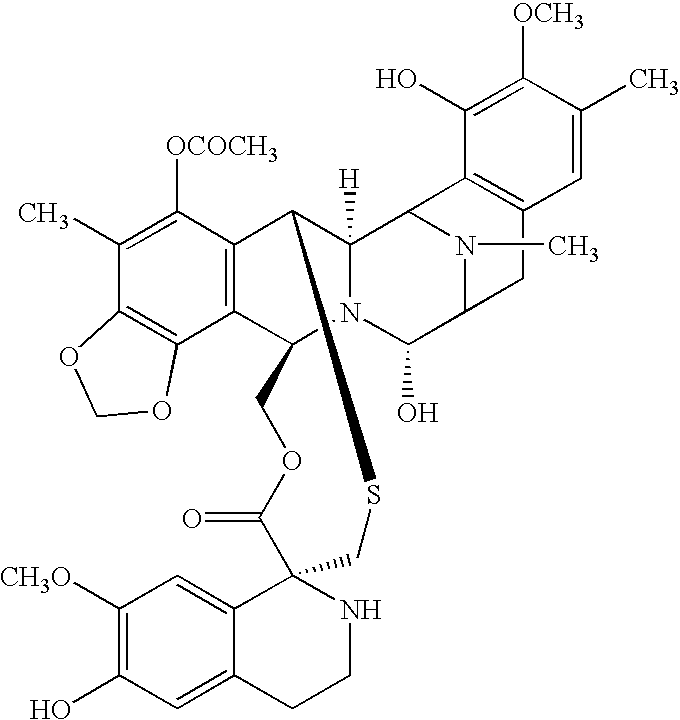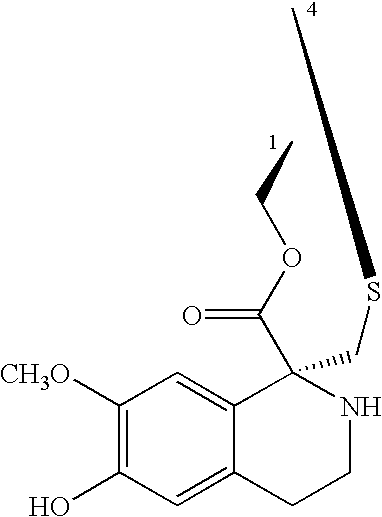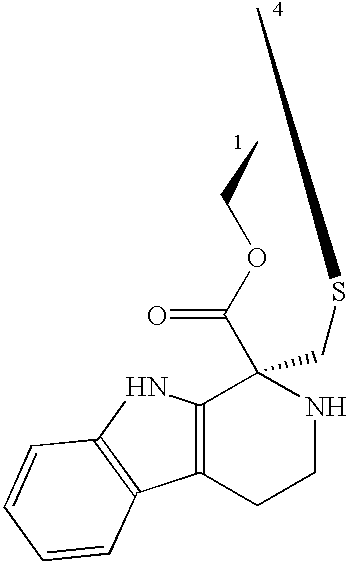Antitumoral analogs of et-743
a technology of antitumoral analogs and et743, which is applied in the field of antitumoral analogs of et743, can solve the problems of long and complicated claims methods
- Summary
- Abstract
- Description
- Claims
- Application Information
AI Technical Summary
Benefits of technology
Problems solved by technology
Method used
Image
Examples
example 1
[0349]
[0350]To a solution of 2 (21.53 g, 39.17 ml) in ethanol (200 ml), tert-butoxycarbonyl anhydride (7.7 g, 35.25 ml) was added and the mixture was stirred for 7 h at 23° C. Then, the reaction was concentrated in vacuo and the residue was purified by flash column chromatography (SiO2, hexane:ethyl acetate 6:4) to give 14 (20.6 g 81%) as a yellow solid.
[0351]Rf: 0.52 (ethyl acetate:CHCl3 5:2).
[0352]1H NMR (300 MHz, CDCl3): δ 6.49 (s, 1H), 6.32 (bs, 1H) 5.26 (bs, 1H), 4.60 (bs, 1H), 4.14 (d, J=2.4 Hz, 1H), 4.05 (d, J=2.4 Hz, 1H), 3.94 (s, 3H), 3.81 (d, J=4.8 Hz, 1H), 3.7 (s, 3H), 3.34 (br d, J=7.2 Hz, 1H), 3.18–3.00 (m, 5H), 2.44 (d, J=18.3 Hz, 1H), 2.29 (s, 3H), 2.24 (s, 3H), 1.82 (s, 3H), 1.80–1.65 (m, 1H), 1.48 (s, 9H), 0.86 (d, J=5.7 Hz, 3H)
[0353]13C NMR (75 MHz, CDCl3): δ 185.5, 180.8, 172.7, 155.9, 154.5, 147.3, 143.3, 141.5, 135.3, 130.4, 129.2, 127.5, 120.2, 117.4, 116.9, 80.2, 60.7, 60.3, 58.5, 55.9, 55.8, 54.9, 54.4, 50.0, 41.6, 40.3, 28.0, 25.3, 24.0, 18.1, 15.6, 8.5.
[035...
example 2
[0355]
[0356]To a stirred solution of 14 (20.6 g, 31.75 ml) in CH3CN (159 ml), diisopropylethylamine (82.96 ml, 476.2 ml), methoxymethylene bromide (25.9 ml, 317.5 ml) and dimethylaminopyridine (155 mg, 1.27 ml) were added at 0° C. The mixture was stirred at 23° C. for 24 h. The reaction was quenched at 0° C. with aqueous 0.1N HCl (750 ml) (pH=5), and extracted with CH2Cl2 (2×400 ml). The organic phase was dried (sodium sulphate) and concentrated in vacuo. The residue was purified by flash column chromatography (SiO2, gradient hexane:ethyl acetate 4:1 to hexane:ethyl acetate 3:2) to give 15 (17.6 g, 83%) as a yellow solid.
[0357]Rf: 0.38 (hexane:ethyl acetate 3:7).
[0358]1H NMR (300 MHz, CDCl3): δ 6.73 (s, 1H), 5.35 (bs, 1H), 5.13 (s, 2H), 4.50 (bs, 1H), 4.25 (d, J=2.7 Hz, 1H), 4.03 (d, J=2.7 Hz, 1H), 3.97 (s, 3H), 3.84 (bs, 1H), 3.82–3.65 (m, 1H), 3.69 (s, 3H), 3.56 (s, 3H), 3.39–3.37 (m, 1H), 3.20–3.00 (m, 5H), 2.46 (d, J=18 Hz, 1H), 2.33 (s, 3H), 2.23 (s, 3H), 1.85 (s, 3H), 1.73–1.6...
example 3
[0361]
[0362]To a flask containing 15 (8 g, 1.5 ml) in methanol (1.61) an aqueous solution of 1M sodium hydroxide (3.2 l) was added at 0° C. The reaction was stirred for 2 h at this temperature and then, quenched with 6M HCl to pH=5. The mixture was extracted with ethyl acetate (3×1 l) and the combined organic layers were dried over sodium sulphate and concentrated in vacuo. The residue was purified by flash column chromatography (SiO2, gradient CHCl3 to CHCl3:ethyl acetate 2:1) to afford 16 (5.3 mg, 68%).
[0363]Rf: 0.48 (CH3CN:H2O 7:3, RP-C18)
[0364]1H NMR (300 MHz, CDCl3): δ 6.73 (s, 1H), 5.43 (bs, 1H), 5.16 (s, 2H), 4.54 (bs, 1H), 4.26 (d, J=1.8 Hz, 1H), 4.04 (d, J=2.7 Hz 1H), 3.84 (bs, 1H), 3.80–3.64 (m, 1H), 3.58 (s, 3H), 3.41–3.39 (m, 1H), 3.22–3.06 (m, 5H), 2.49 (d, J=18.6 Hz 1H) 2.35 (s, 3H), 2.30–2.25 (m, 1H), 2.24 (s, 3H), 1.87 (s, 3H), 1.45–1.33 (m, 1H), 1.19 (s, 9H), 1.00 (br d, J=6.6 Hz 3H)
[0365]13C NMR (75 MHz, CDCl3): δ 184.9, 180.9, 172.6, 154.7, 151.3, 149.1, 148.6, 14...
PUM
| Property | Measurement | Unit |
|---|---|---|
| pH | aaaaa | aaaaa |
| temperature | aaaaa | aaaaa |
| temperature | aaaaa | aaaaa |
Abstract
Description
Claims
Application Information
 Login to View More
Login to View More - R&D
- Intellectual Property
- Life Sciences
- Materials
- Tech Scout
- Unparalleled Data Quality
- Higher Quality Content
- 60% Fewer Hallucinations
Browse by: Latest US Patents, China's latest patents, Technical Efficacy Thesaurus, Application Domain, Technology Topic, Popular Technical Reports.
© 2025 PatSnap. All rights reserved.Legal|Privacy policy|Modern Slavery Act Transparency Statement|Sitemap|About US| Contact US: help@patsnap.com



